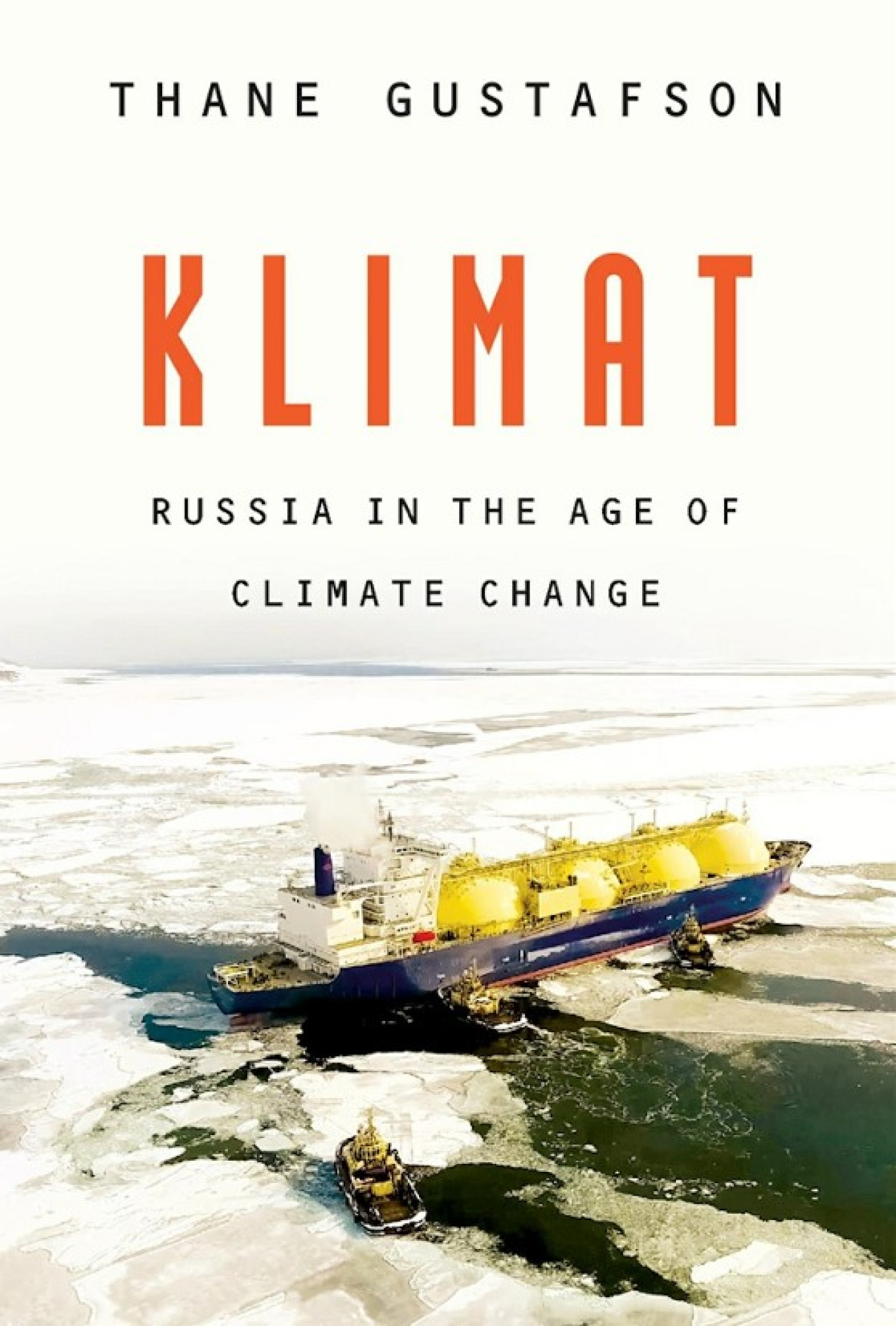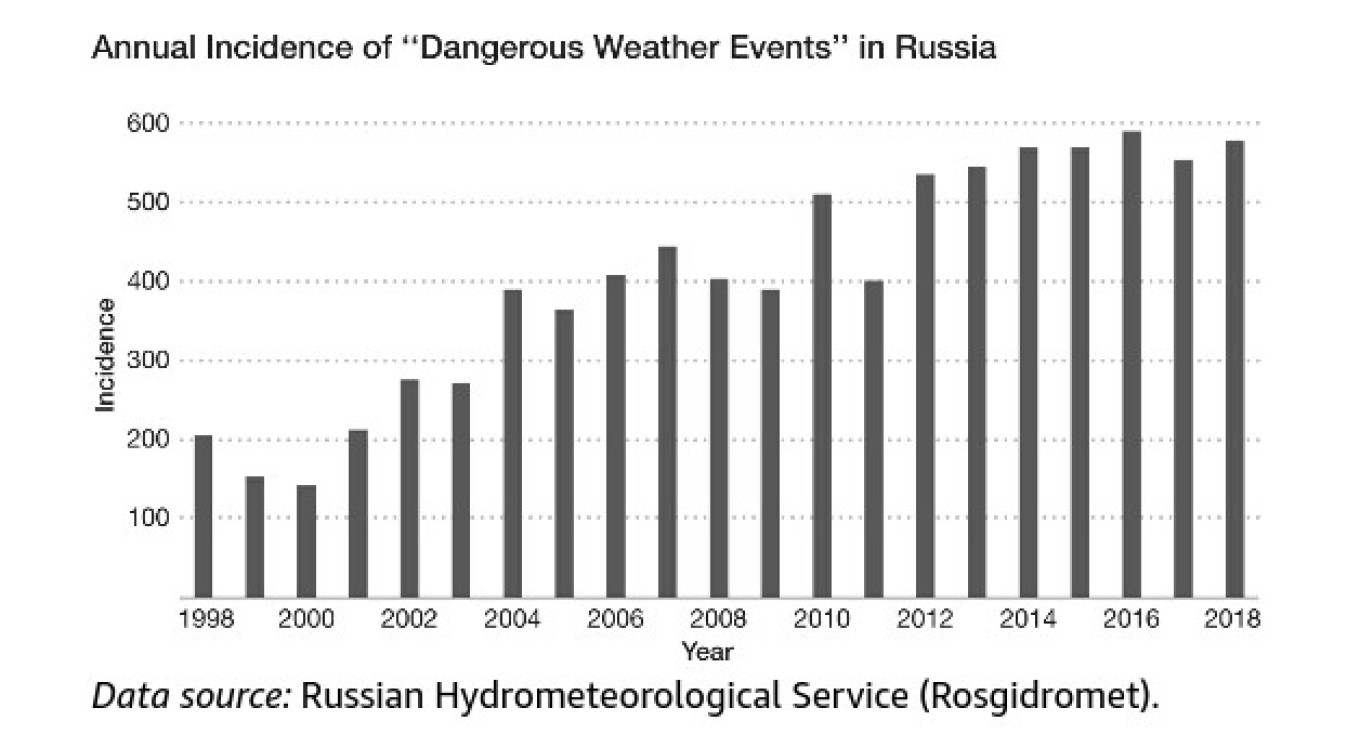Forest fires so massive they dwarf European countries. Oil spills that turn Arctic rivers red. Snow that turns black from coal soot.
Russia, the world’s fourth-largest emitter of greenhouse gasses and a country whose territory is warming 2.5 times faster than the planet as a whole, is already acutely feeling the impacts of climate change.
In his 2022 Pushkin House Book Prize nominee “Klimat: Russia in the Age of Climate Change,” Thane Gustafson offers a thorough, measured, and easy-to-digest analysis exploring how Russia may fare in the increasingly warming planet of the coming decades.
Gustafson is a professor of political science at Georgetown University who specializes in the domestic politics and policymaking of Russia and the former Soviet Union.
His analysis is a sobering one, as Russia’s leaders — largely ignorant or dismissive of climate change — remain zeroed in on maximizing short-term profits and expansion over long-term sustainability and adaptation to post-carbon technologies.
As a result, he argues, the country is woefully unprepared for the climate crisis.
While “Klimat” was written before Russia’s invasion of Ukraine, its contents ring especially true now that the West is meaningfully eschewing Russian energy, hastening Moscow’s pivot eastward, and sanctions have blocked Moscow from receiving new technologies in renewables.
With vignettes on influential figures from fossil fuel tycoons like Igor Sechin and Leonid Mikhelson to former Rosatom chief Sergei Kirienko and renewables proponent Anatoly Chubais, Gustafson illustrates the many different interests at play in Russia’s addressing of the climate crisis.
But the story of Chubais, who was a leader in Russia’s forays into renewable energy over the past decade, has seemingly already come to an end. In March, shortly after the Kremlin sent troops into Ukraine, Chubais resigned from his post as President Vladimir Putin’s special climate envoy and left the country — perhaps for good.

Gustafson acknowledges the very real successes Russia has seen in reviving its nuclear and agricultural sectors in the past two decades, particularly for the export market.
But despite these successes, Russia’s political and business leadership will nonetheless need to take serious steps to adapt as rising temperatures cut into oil and gas exports, the driver of Russia’s economy — and degrades infrastructure across the country’s vast permafrost areas.
Whether they will be able to do so before it’s too late remains to be seen — and could be the cause of their downfall.
Klimat: Russia in the Age of Climate Change

From Chapter Seven: Russia’s Agricultural Renaissance
At this moment Russian agriculture is booming. Over the past two decades, agriculture has become one of Russia’s greatest success stories. For anyone who remembers the miserable performance of Soviet collectivized agriculture, and Russia’s chronic dependence on imported food in the 1970s through the 1990s, this is an astonishing turnaround indeed. Russia is already the world’s largest exporter of wheat, and its output is expanding rapidly across a wide range of foodstuffs. But will Russia’s agricultural renaissance continue in the decades ahead, as climate change worsens? In this chapter we look at how this transformation came about, and what consequences it may have for Russian food security and income from exports in coming decades.
Stalin’s Agricultural Disaster
Stalin plundered the Soviet countryside to drive the development of cities and industry. But the result was mass famine in the countryside, the destruction of the traditional village, and a legacy of impoverished and inefficient farms. Though food production improved somewhat under his successors, food distribution remained abysmal; only half of farm production reached consumers, while the rest spoiled in the fields. Collectivized agriculture was the albatross that hung over the Soviet system for five decades.
Then came the Soviet collapse, bringing still more calamity. The impact on Russian agriculture over the next fifteen years was disastrous. Sown area dropped by one-third country-wide, from about 118 million hectares in 1990 to just under 75 million in 2007. Even in the most productive regions of the south and southwest there were declines of 30 to 40 percent. In the so-called Non–Black Earth zone (in Russian, Nechernozem’e)—a band of less fertile soils ranging from Pskov to Sverdlovsk, Tomsk, and Kemerovo—the amount of sown land dropped by half.
How could such a history of misfortune have been reversed in the mere space of two decades? The answer is a massive change in ownership, consisting initially of wholesale privatization in the 1990s, followed by reconcentration after 2000 in the hands of more efficient producers, chiefly large private agroholdings. Russian agricultural exports have flowed to world markets, while imports from Western countries have been restricted by the state in response to Western sanctions; in both cases the result has been a major stimulus to domestic production. Finally, both central and regional governments provide abundant subsidies to agriculture, although mainly to the largest producers.
This raises a series of fundamental questions about the future, as climate change worsens around the world. First, how solid is the Russian agricultural renaissance, and will it be helped or harmed as temperatures rise? Second, will Russian food exports continue to increase, and what revenues will they contribute? Thirdly, will food for the Russian population be secure? And lastly, what role will Russian agriculture play in the international diplomacy of climate change and the geopolitics of food?
The effects of climate change will be felt in two phases: during the first, running to the end of the 2020s, present trends will continue to drive increases in food production, exports, and revenue. But the following two decades, to mid-century, will bring a slow but steady erosion, although this might be offset by a rise in export prices. This erosion will be due to a conjunction of six causes: externally, the evolution of global markets; internally, the steady worsening of direct effects from climate change; limits to the expansion of agricultural land; the longer-term effects of changes in land ownership; the impact of land reclamation policies; and finally, trends in financial aid from the state. We examine each of these in turn.
Russian Agriculture in Global Context
The story of Russian agriculture will play out against the backdrop of a deteriorating global environment. The worst impact of climate change is likely to be felt on the world’s agriculture and food supply. The United Nations’ Food and Agriculture Organization (FAO) warns that if global population reaches 9.5 billion by 2050—as it is currently on track to do—the world will need to increase food production by 60 percent compared to today. Yet the FAO projects that food supply could decline by 10 to 25 percent.
Agriculture itself adds to climate change, accounting for about one-quarter of greenhouse gas emissions worldwide.7 But it contributes to the coming crisis in other ways as well. Traditional agricultural practices in many parts of the world overuse water and abuse the soil. As a result, rivers and seas dry up, soils become laden with salt, ground erodes, and water tables sink deeper and can no longer support irrigation. In many places, fertility is already declining. These problems will worsen as climate change advances, an awareness that has led to growing calls for wholesale reform of food production as well as deep changes in the ways the world processes and consumes food. But the inertia of the world agricultural system is so great that change will not come quickly.

What role does Russian agriculture play in climate change? Russia is the world’s fourth-largest emitter of greenhouse gases (GHG). Agriculture alone accounts for 15 to 18 percent of Russia’s GHG emissions, and together with the food industry it produces 25 to 28 percent of Russia’s total, chiefly in the form of carbon dioxide and nitrogen oxide but also substantial amounts of methane from livestock. This basic picture is unlikely to change because sustainable agriculture takes up only a very small share of total farmland and is unlikely to grow significantly any time soon.
Russian agriculture will not escape the effects of climate change. Temperatures are rising 2.5 times faster in Russia than in the rest of the world. Between 1998 and 2018, there was a 300 percent increase in what Russian statistics call dangerous weather events. These include floods and fire, but the greatest threat is drought, combined with increasingly violent rains.
Russian Perceptions and Initial Responses
These trends are causing Russian scientists and government officials to focus on changing weather patterns and their possible impact on food production. Yet on the local level there is still widespread skepticism about climate change as an explanation, particularly among farmers and local officials, and there is not yet any meaningful action to address it. For example, the commercial director of one large agroholding expresses a typical attitude, as he shrugs, “In some places it’s worse, in some places it’s better, but on average all the changes are within some sort of statistical error.” The major agroholdings report that their average yields over the last decade have been no lower than normal. As far as the large farms are concerned, it all balances out. The statistics bear them out: between 2000 and 2018, average yields of grain and pulses have increased by half; and the last decade has been especially favorable. There has not been a major crop failure since 2012.
Most players in the food sector do not yet believe climate change is real. Understandably, they have focused in recent years on Russia’s own “agricultural miracle.” Indeed, in the past two decades times have never been so good. The revolution in Russian food production is still gathering strength. Total grain harvests have nearly doubled since the end of the 1990s, and they are still growing. According to Stephen Wegren, the West’s leading authority on the Russian food sector, “Russia has emerged as a grain powerhouse.” This is a very recent development: it was only in 2016 that Russian grain production returned to Soviet levels. But now grain exports in the best years are above 50 million tons. Revenues from agricultural exports, led by grain, now exceed $25 billion per year (wheat alone is about $8 billion), and President Putin has set a target of $45 billion by 2024. Export income from agriculture runs well ahead of arms sales (which Putin estimated in 2018 at about $15 billion per year), and ranks third after oil and gas. The outlook for exports over the next decade, at least on the eve of the COVID-19 pandemic, appeared bright.
A major turning point in state agricultural policy came in 2014, when Putin responded to the West’s economic sanctions after the annexation of Crimea by instituting countersanctions to ban many categories of food imports, notably from Europe. The result has been a boom in domestic production, notably of meat and dairy products, which has reversed a long-standing decline in Russian livestock. Russians now pay higher prices for many types of food, but production is increasingly of domestic origin, and, as noted, food imports have declined steadily. For the foreseeable future, food security seems assured.
In short, there is not yet a sense of coming trouble, at least within the agricultural sector. But what will the longer-range impact of climate change be, particularly after the 2020s, and how will Russian farmers, scientists, and officials react to it?
Climate Change: Positive or Negative?
Climate change will alter the geography of Russian agriculture. A convenient way to think about the impact of climate change is to visualize a horizontal band, optimal for cultivation, that gradually moves north as temperatures increase. The southern boundary of the band is defined by increasing heat and drought, with negative effects on crop yields, especially in European Russia, where two-thirds of the territory is short of water. Grains, and wheat in particular, are highly susceptible to drought. The northern boundary is defined by increasing warmth and rain, with generally positive consequences. The net effect depends on how these three factors—warmth, rainfall, and length of growing season—combine. Russian models suggest that an increase of 1 degree Centigrade is likely to be positive for overall yields, but 2.5 degrees and above will be negative, and 3.5 degrees strongly negative. In Siberia, where climate is more continental, the negative effects of climate change are likely to predominate.
Predicting the impact of climate change on Russian agriculture is complicated by the fact that there are so many different regional environments across the enormous expanse of Russia, and they will be affected differently by rising temperatures. Nevertheless, some broad generalizations are possible. In the north and east, the main problem will be excessive rainfall; in the south and west—the areas of greatest production of Russia’s grain exports—the main problem will be drought. Both will become more intense as the twenty-first century advances, particularly after the 2030s, with more frequent extremes, especially heat waves, throughout the country. More intense rains will lead to greater flooding, even in southern areas.
The impact on productivity will be especially severe in the south, where most of the country’s grain exports come from. According to a 2018 report signed by Aleksandr Bedritsky, who was at that time the chief climate advisor, yields (urozhainost’) in the grain-producing regions may decline by 5 to 10 percent by mid-century. Some predictions are more dramatic. For example, academician Andrei Paptsov, a prominent authority on agricultural economics, draws from an extensive study by the Institute for Agricultural Meteorology to warn that grain yields will decline by 7 percent by mid-century and feed grains by 17 percent, while in the more marginal Volga and Ural regions the declines in the yields of feed grains will be 30 percent and 38 percent, respectively.
In contrast, the impact on more northerly regions of European Russia, especially the Non–Black Earth zone might be positive. These are areas that grow vegetables and fruits, and raise animals for meat, dairy products, and eggs, especially in clusters around the big cities. If their yields expand, the range and security of domestic supply could improve. One Russian journalist has joked, “We could have pears from Riazan’ and apricots from Tula.”
From this basic picture, one might be inclined to conclude that Russian agriculture should be able to adapt successfully to climate change by moving its center of gravity to the north, opening up unused land in the north while expanding reclamation in the south. Adaptation becomes essentially a question of time and investment. [But] this notion of a moving band soon runs into a central problem: as one moves north, Russian soils become increasingly marginal.
Excerpted from “Klimat: Russia in the Age of Climate Change” by Thane Gustafson, published by Harvard University Press. Copyright © 2021 by the President and Fellows of Harvard College. Used by permission. All rights reserved. Footnotes have been removed to ease reading. For more information about the author and this book, see the publisher’s site here.
“Klimat: Russia in the Age of Climate Change” has been shortlisted for the 2022 Pushkin House Book Prize.
Leave a Reply